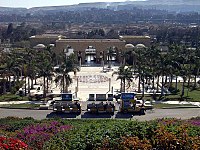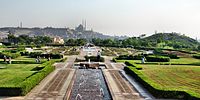al-Azhar Park
The al-Azhar Park ( in Arabic حديقة الأزهر, DMG Ḥadīqat al-Azhar ) is a public garden in the Egyptian capital Cairo . The park opened in 2005 on 30 hectares. The plant was financed by the Aga Khan Development Network (AKDN) with 30 million dollars as a gift from Aga Khan IV. , Whose ancestors founded the city of Cairo in 969. It is the largest public park in Cairo. Previously there was a garbage dump at this point that had piled up in 500 years. The park is located on a hill above the Azhar Mosque .
City walls from the Ayyubid period , which Saladin had built in the 12th century, were found near the park . The walls have been restored and integrated into the garden. The project also included the restoration of the Um Sultan Shaban mosque from the 14th century, the Khayrbek complex from the 13th century and the Darb Shoughlan school . There are also facilities for social and health services in the park.
prehistory
In 1984 Karim Aga Khan visited Cairo and from his hotel saw the hill al-Darassa with its mountains of rubbish. He offered the city to create a green lung in the metropolis of Cairo at this point. The work began in 1992. Over 765,000 cubic meters of material were removed, 160,000 cubic meters of which were used for replenishment elsewhere. 605,000 cubic meters were treated geotechnically and mixed with 60,000 cubic meters of special sand and topsoil. The property was covered with this earth mixture. A total of 1.5 million cubic meters of rubble and earth were moved, which corresponds to the load of 80,000 trucks. The hill on which the park is located is about 55 meters high, which is at least 25 meters higher than the rest of the city in the Nile plain .
During the planning phase, the Egyptian government asked for three cisterns to be integrated into the system for the city's drinking water supply. The planning had to be interrupted and completely changed for this.
The park
The park is essentially divided into five sections: two hills, one in the north and one in the south, a gently curved terrain to the east, a flat terrain in the north and a steep slope in the west.
The avenue of palm trees in Azhar Park with a view of the Muhammad Ali Mosque
The planners attached great importance to integrating Islamic garden art traditions into design and botany in order to commemorate the city's past. For example, styles from different regions and different epochs were used for the gardens and buildings in the park, for the orchards, the seating in the shade and the Fatimid arcades. Persian and Timurid elements can be found on the watercourses and fountains. The garden is thus reminiscent of historical Islamic garden art. The area is fed by its own water reservoir. There are also cafes, children's playgrounds and viewpoints of the city.
Restoration of the Ayyubid city wall
While the ground was being dug, an archaeological treasure was found under the mountains of rubbish: a 15-meter-high wall 1.5 kilometers in length. This forgotten Ayyubid city wall and its towers have been restored and it was decided to incorporate them into the garden project.
The historical city walls of the Ayyubids
[The] segment of wall constitutes a uniform piece of construction. It comprises a few repeating elements, such as round-fronted towers and curtain walls, and is consistent in its use of materials. […] The walls are adorned and punctuated by crenellations, arrow slits, stairwells and chambers.
“ [This] section of the wall is constructed uniformly. It consists of a few repetitive elements such as round towers and facades and is uniform in the use of materials. […] The walls are decorated and interrupted by battlements, loopholes, stairwells and chambers. "
Darb al-Ahmar district
Darb al-Ahmar, the neighborhood next to the park, is one of the poorest in Cairo, with no sanitary facilities or garbage disposal. With the creation of the park and the upgrading of the area, the danger of gentrification was recognized and the displacement of the long-established population was feared. There are also over 60 historical monuments in the district that were in poor condition. Aga Khan made further funds available for a program for the further development of this district and brought other foundations on board.
Measures were taken to strengthen the structures of the district. The entire population was involved in the design and construction of the park. The layout of the gardens also offered work to many of the residents of the district. B. made the furniture for the buildings. Courses were offered in old handicrafts, but also for computers, automotive electronics, office work and more. In addition, over 400 microloans were granted. Special courses were offered for women who e.g. B. made up 59 percent of all offers in 2008.
In addition, three buildings in the district have been restored, the Khayerbek complex , a monument from Mameluk and Ottoman times, and the Umm al-Sultan Shaaban mosque . The Darb Shoghlan School has been restored to serve as the headquarters of the development company.
We rebuilt the minaret of the mosque and madrasa of Umm al-Sultan Shaaban based on research and studies on the previous minaret, which collapsed during an earthquake. We rebuilt it in order to show people what it looked like, in order to re-create the past, which might be lost forever otherwise. [...] We not only restore monuments, but we also aim to make them functional and beneficial for the users.
“ We have rebuilt the minaret of the mosque and madrasa of Umm al-Sultan Shaaban based on research and study of the previous minarets that collapsed in an earthquake. We rebuilt it to show people how it used to be and to recreate the past that would otherwise have been lost forever. […] Not only did we restore monuments, our goal was that they should also be functional and useful for the users. "
Urban Plaza and the Museum of Historic Cairo
An urban plaza is under construction at the north end of the park to house the Museum of Historic Cairo . The plaza is to house a multifunctional center with shops, cultural offerings and a parking garage. It is being built by the Aga Khan Trust for Culture in collaboration with the Supreme Council of Antiquities of Egypt.
The museum will depict the history of Cairo. On 4,000 square meters, spread over two floors, 1,000 objects from different epochs are to be exhibited that were previously not on view. In order to restore and preserve the artifacts, a laboratory was set up in which young technicians are trained for this field of activity.
Awards
- Al-Azhar Park is listed among the 60 “World's Great Places” by the Project for Public Spaces .
- 2005: Global Vision Innovation Award.
Movie
- Amazing Gardens - The Al-Azhar Park in Egypt. (OT: Étonnants jardins. Le jardin Al-Azhar, Égypte. ) Documentary, France, 2017, 26:02 min., Script and director: Stéphane Carrel, production: arte France, Cinétévé, series: Amazing gardens (OT: Étonnants jardins ), First broadcast: September 17, 2017 by arte, table of contents by ARD , u. a. with the landscape architects Dr. Laila El-Masry-Stino and Maher Stino, the botanist Dr. El-Saady Badawy and the park manager Sherif Erian.
Web links
- Al-Azhar Park Administration (English)
- Al-Azhar Park. In: archnet.org , (English)
- Nevine El-Aref: Aga Khan Trust revives the Middle Ages. ( Memento from March 25, 2013 in the Internet Archive ). In: Al-Ahram Weekly , November 11, 2007, (English)
Individual evidence
- ↑ a b Brochure: Al-Azhar Park, Cairo and the Revitalization of Darb Al-Ahmar. Project Brief. ( Memento of March 14, 2016 in the Internet Archive ). In: The Agha Khan Trust for Culture , 2005, (PDF; 16 p., 681 kB).
- ^ D. Fairchild Ruggles: Islamic Gardens and Landscapes . University of Pennsylvania Press, 2008, ISBN 0-8122-4025-1 , p. 168.
- ^ Elsa Bourguignon: Study of Deterioration mechanisms and protective treatments for the Egyptian Limestone of the Ayyubid city wall of Cairo. In: University of Pennsylvania , Dissertation , 2000, (PDF; 239 p., 5.5 MB, with illustrations; download options .)
- ↑ Haysam Nour ( Politecnico di Milano ): Sustainability in Al Darb Al Ahmar District: An Egyptian Experience. In: sb10mad.com , 28. – 30. April 2010, ( Sustainable building conference ), (PDF; 12 pp., 284 kB).
- ↑ Khaled El-Khishin (University of Benha, Egypt): Cairo's Al-Azhar Park: Millennium Development Goals Etched In Green. In: Journal of the Malaysian Institute of Planners , 2006, No. 4, pp. 23-30.
- ↑ Quoted in Rose Aslan: Rescuing Cairo's Lost Heritage. ( Memento of April 2, 2007 in the Internet Archive ). In: Islamica Magazine , October 20, 2006.
- ↑ Randa Achmawi: museum to tell the history of Cairo. ( Memento of May 10, 2008 in the Internet Archive ) In: anba.com , November 15, 2006.
- ^ Brian Geraghty: Al-Azhar Park (Cairo, Egypt). ( Memento of the original from March 16, 2017 in the Internet Archive ) Info: The archive link was automatically inserted and not yet checked. Please check the original and archive link according to the instructions and then remove this notice. In: Project for Public Spaces (PPS), December 5, 2008.
- ^ T + L 2005 Global Vision Awards • Innovation • Recognizing a recent venture that has changed the landscape of responsible tourism through its sheer ingenuity • Al-Azhar Park, Cairo. ( Memento from December 1, 2006 in the Internet Archive ). In: Travel + Leisure , 2005.
Coordinates: 30 ° 2 ′ 24.5 ″ N , 31 ° 15 ′ 54.2 ″ E








